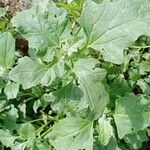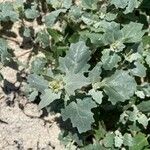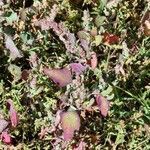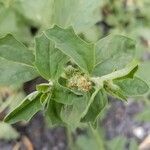Erect, usually much-branched, to 2 m; lvs lanceolate to rhombic-ovate, to 7 cm, deeply sinuate-dentate, thinly gray-scurfy; staminate fls in the uppermost axils and in terminal spikes less than 1 cm; pistillate fls axillary; fruiting bracteoles broadly ovate to rhombic, 4–10 mm long and wide, conspicuously dentate, united to the middle, the central part indurate; tubercles none to several; veins conspicuous, many with free tips; 2n=18. Native of Eurasia, established as a weed in alkaline soil in w. U.S. and occasionally found in waste places in our range.
An annual herb. It grows 30-50 cm tall. They plant is grey and scaly. The leaves are oval and 2-4 cm long by 5-12 mm wide. The flowers are in spikes at the end of shoots and also along the sides. The seeds are round but flattened. They have bracts around them.




